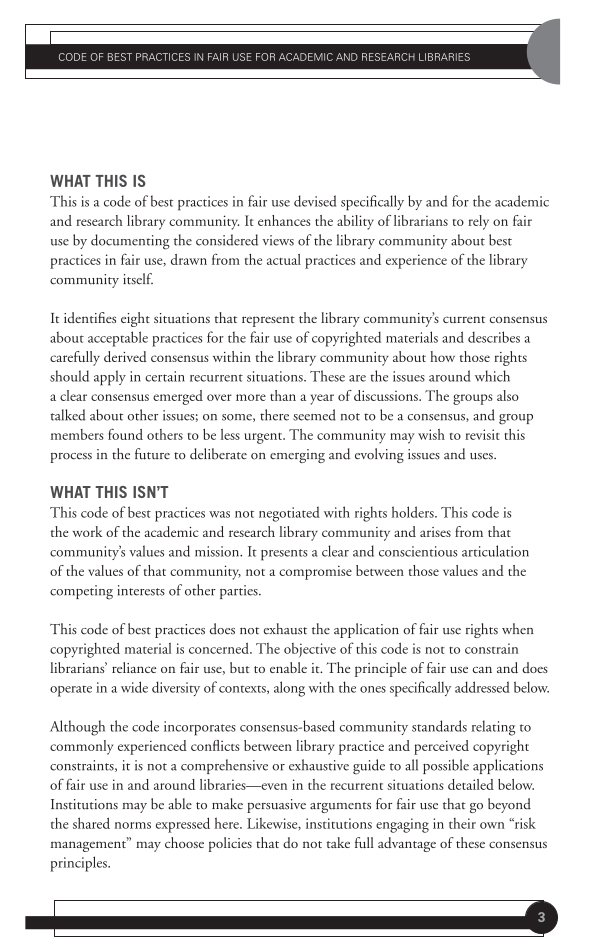CODE OF BEST PRACTICES IN FAIR USE FOR ACADEMIC AND RESEARCH LIBRARIES
3
WHAT THIS IS
This is a code of best practices in fair use devised specifically by and for the academic
and research library community. It enhances the ability of librarians to rely on fair
use by documenting the considered views of the library community about best
practices in fair use, drawn from the actual practices and experience of the library
community itself.
It identifies eight situations that represent the library community’s current consensus
about acceptable practices for the fair use of copyrighted materials and describes a
carefully derived consensus within the library community about how those rights
should apply in certain recurrent situations. These are the issues around which
a clear consensus emerged over more than a year of discussions. The groups also
talked about other issues on some, there seemed not to be a consensus, and group
members found others to be less urgent. The community may wish to revisit this
process in the future to deliberate on emerging and evolving issues and uses.
WHAT THIS ISN’T
This code of best practices was not negotiated with rights holders. This code is
the work of the academic and research library community and arises from that
community’s values and mission. It presents a clear and conscientious articulation
of the values of that community, not a compromise between those values and the
competing interests of other parties.
This code of best practices does not exhaust the application of fair use rights when
copyrighted material is concerned. The objective of this code is not to constrain
librarians’ reliance on fair use, but to enable it. The principle of fair use can and does
operate in a wide diversity of contexts, along with the ones specifically addressed below.
Although the code incorporates consensus-based community standards relating to
commonly experienced conflicts between library practice and perceived copyright
constraints, it is not a comprehensive or exhaustive guide to all possible applications
of fair use in and around libraries—even in the recurrent situations detailed below.
Institutions may be able to make persuasive arguments for fair use that go beyond
the shared norms expressed here. Likewise, institutions engaging in their own “risk
management” may choose policies that do not take full advantage of these consensus
principles.
3
WHAT THIS IS
This is a code of best practices in fair use devised specifically by and for the academic
and research library community. It enhances the ability of librarians to rely on fair
use by documenting the considered views of the library community about best
practices in fair use, drawn from the actual practices and experience of the library
community itself.
It identifies eight situations that represent the library community’s current consensus
about acceptable practices for the fair use of copyrighted materials and describes a
carefully derived consensus within the library community about how those rights
should apply in certain recurrent situations. These are the issues around which
a clear consensus emerged over more than a year of discussions. The groups also
talked about other issues on some, there seemed not to be a consensus, and group
members found others to be less urgent. The community may wish to revisit this
process in the future to deliberate on emerging and evolving issues and uses.
WHAT THIS ISN’T
This code of best practices was not negotiated with rights holders. This code is
the work of the academic and research library community and arises from that
community’s values and mission. It presents a clear and conscientious articulation
of the values of that community, not a compromise between those values and the
competing interests of other parties.
This code of best practices does not exhaust the application of fair use rights when
copyrighted material is concerned. The objective of this code is not to constrain
librarians’ reliance on fair use, but to enable it. The principle of fair use can and does
operate in a wide diversity of contexts, along with the ones specifically addressed below.
Although the code incorporates consensus-based community standards relating to
commonly experienced conflicts between library practice and perceived copyright
constraints, it is not a comprehensive or exhaustive guide to all possible applications
of fair use in and around libraries—even in the recurrent situations detailed below.
Institutions may be able to make persuasive arguments for fair use that go beyond
the shared norms expressed here. Likewise, institutions engaging in their own “risk
management” may choose policies that do not take full advantage of these consensus
principles.


































